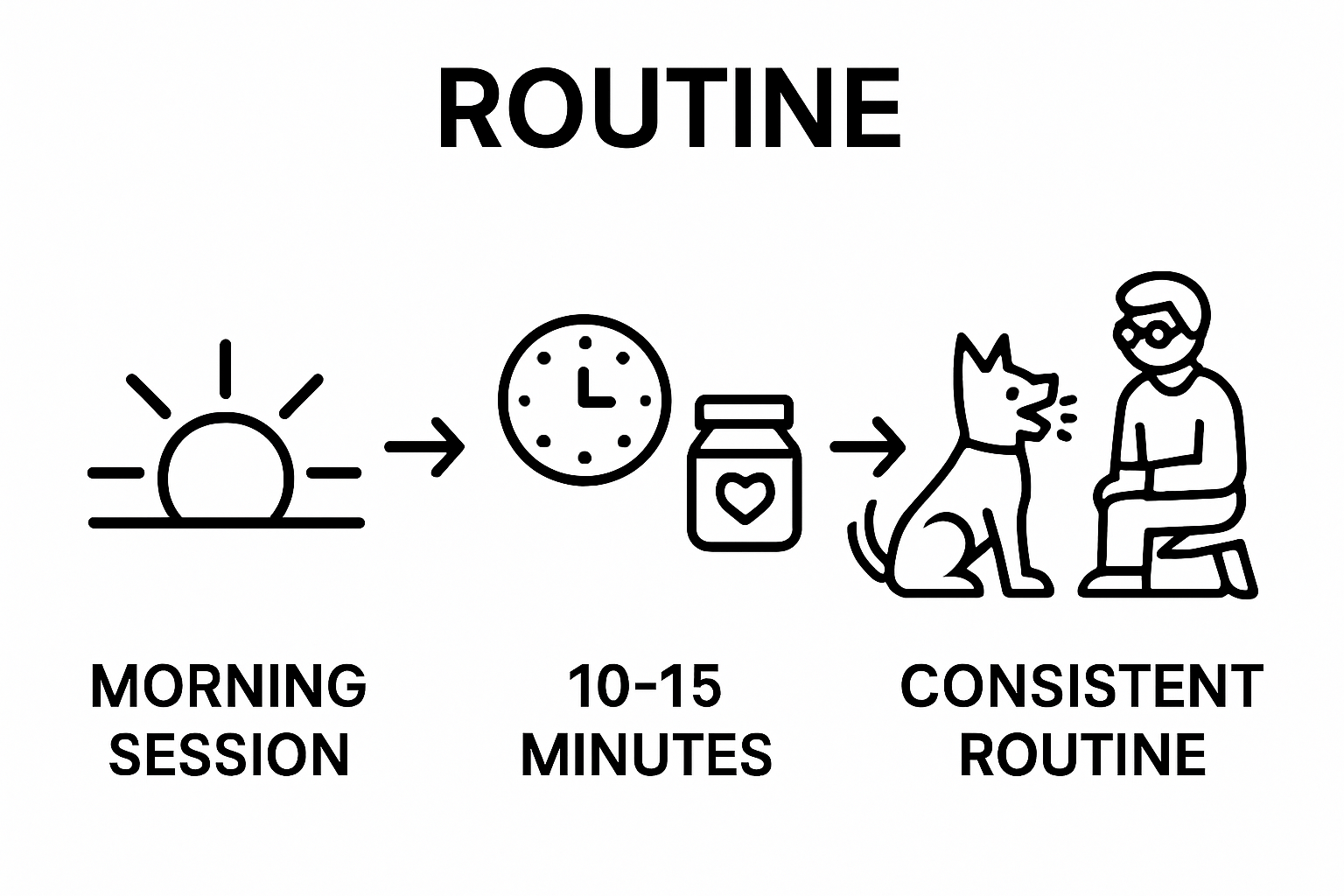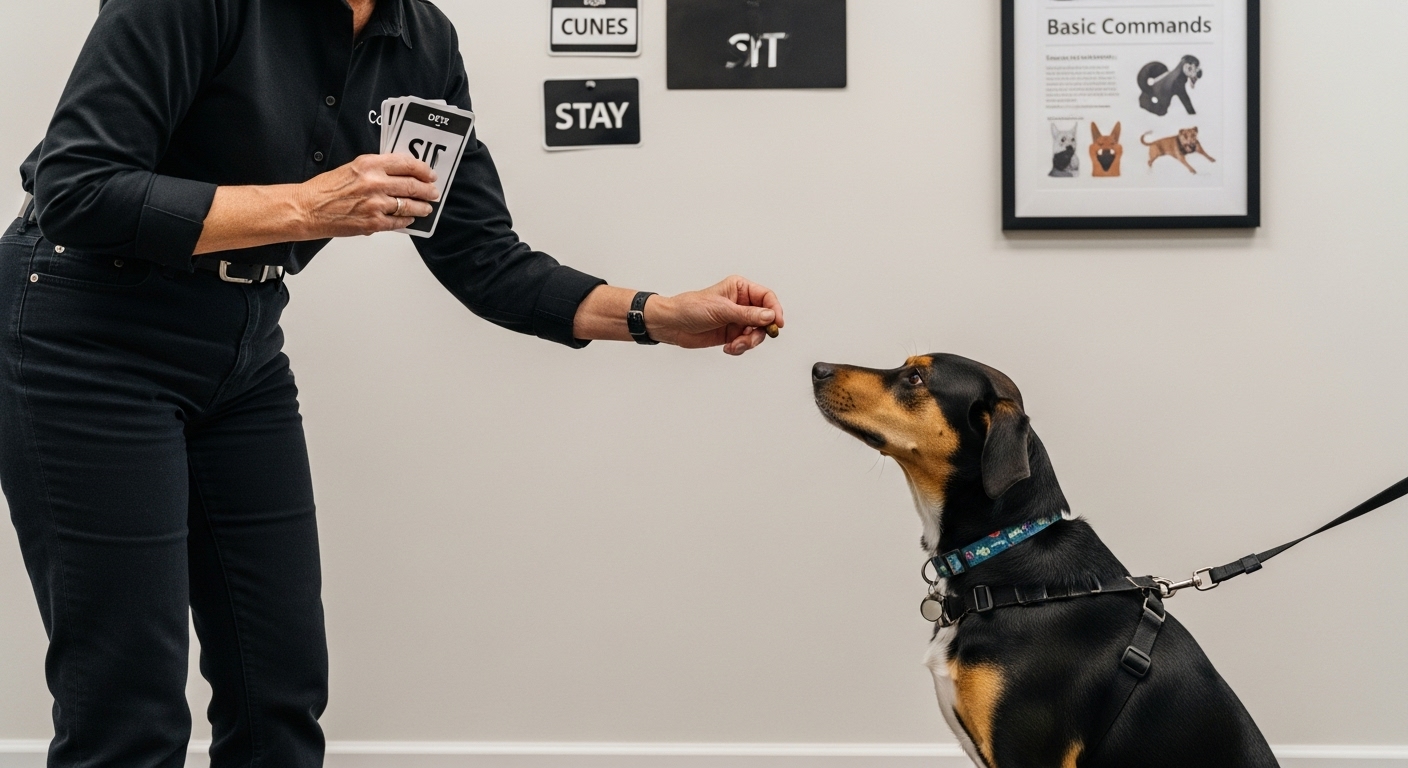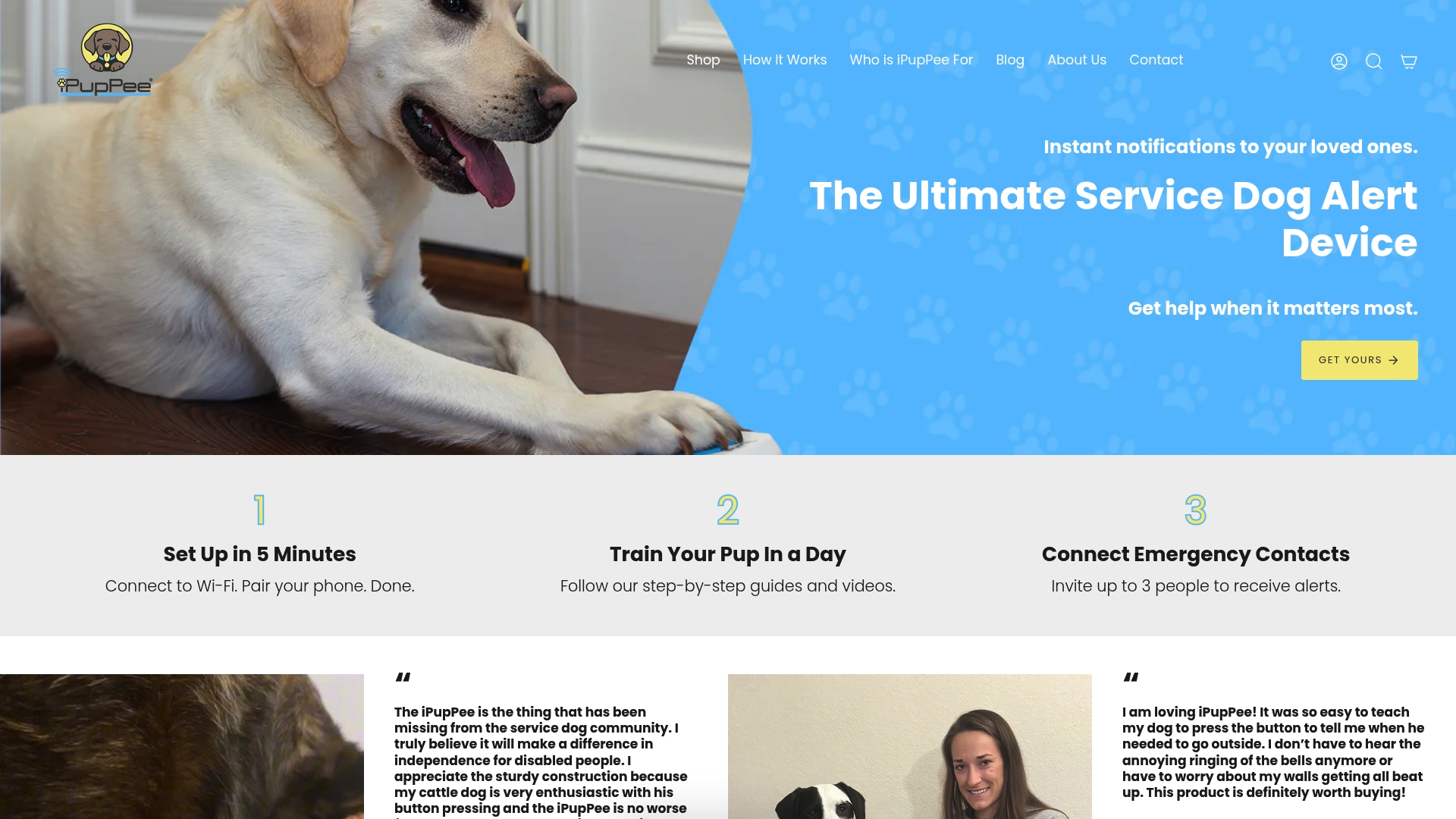Training a dog as a senior can feel overwhelming at first. You might think pet ownership gets harder with age, especially with so many safety and health concerns in mind. But studies show that only 15 minutes of consistent daily training can drastically improve safety and well-being for both dogs and elderly owners. Many people are surprised to learn the right routine not only builds a strong bond but also makes home life safer and more joyful for everyone involved.
Table of Contents
- Step 1: Assess Your Home Environment For Safety
- Step 2: Choose Appropriate Training Methods For Seniors
- Step 3: Establish A Consistent Training Routine
- Step 4: Teach Basic Commands And Cues
- Step 5: Reinforce Training With Positive Experiences
- Step 6: Evaluate Behavior And Make Adjustments
Quick Summary
| Key Point | Explanation |
|---|---|
| 1. Assess your home for safety | Check for hazards like sharp edges and clutter that can impede training or pose risks during interaction. |
| 2. Use positive reinforcement methods | Focus on rewarding good behavior with treats and praise, ensuring a compassionate training experience. |
| 3. Maintain a consistent training routine | Establish a reliable schedule with short sessions to build trust and improve learning for both handler and dog. |
| 4. Teach basic commands clearly | Start with simple commands like ‘sit’ and ‘stay’ to enhance communication and safety between handler and dog. |
| 5. Regularly evaluate behavior and adjust | Keep a detailed journal to track progress and adapt training techniques as needed based on your dog’s responses. |
Step 1: Assess Your Home Environment for Safety
Training dogs for seniors begins with creating a safe, predictable environment that supports successful learning and interaction. Before introducing a new dog into your living space, carefully evaluating your home becomes a critical first step in establishing a secure foundation for both you and your canine companion.
Start by conducting a comprehensive walkthrough of your living areas, examining each room from a dog’s perspective. Look for potential hazards that could compromise safety or interfere with training. Sharp edges, loose electrical cords, unstable furniture, and small objects that could be swallowed require immediate attention. Senior pet owners must be particularly vigilant, as mobility challenges can make navigating obstacles more difficult for both human and dog.
Physical modifications can significantly enhance home safety. Consider installing non-slip mats in high-traffic areas, securing loose rugs, and creating clear pathways that accommodate potential mobility limitations. Removing clutter and organizing spaces not only reduces tripping risks but also provides a more structured environment conducive to dog training. Learn more about creating safe home environments for dogs to ensure a smooth transition.
Key safety verification steps include:
- Ensuring all toxic substances are stored in locked cabinets
- Removing small objects that could present choking hazards
- Creating a designated safe space for your dog with comfortable bedding
- Installing baby gates to restrict access to potentially dangerous areas
By meticulously preparing your home environment, you establish a solid groundwork for successful dog training.
Below is a checklist table to help seniors evaluate home safety before starting dog training, summarizing the key safety verification steps from the guide.
| Safety Check | What to Do | Purpose |
|---|---|---|
| Secure toxic substances | Store in locked cabinets | Prevent accidental poisoning |
| Remove small objects | Eliminate items that could be swallowed | Avoid choking hazards |
| Create safe dog space | Set up comfortable bedding in a designated area | Provide your dog with security |
| Install baby gates | Restrict dog access to dangerous locations | Enhance overall home safety |
| Eliminate sharp hazards | Cover sharp edges and secure loose cords or furniture | Reduce risk of injury |
| Add non-slip surfaces | Place non-slip mats in high-traffic locations | Prevent slips and falls |
| Declutter pathways | Remove clutter and create clear walking paths | Support mobility for all |
Step 2: Choose Appropriate Training Methods for Seniors
Selecting the right training approach is crucial when working with dogs for seniors, as the method must accommodate both the dog’s learning style and the handler’s physical capabilities. Positive reinforcement techniques stand out as the most effective and compassionate strategy, focusing on rewarding desired behaviors rather than punishing unwanted actions.
The core of successful training lies in understanding each dog’s unique personality and learning pace. Senior handlers benefit most from methods that emphasize patience, consistency, and short, engaging training sessions. Break down complex commands into smaller, manageable steps, allowing both dog and handler to build confidence gradually. Explore our comprehensive guide on proven training techniques to refine your approach.
Practical training approaches should consider physical limitations. Use verbal praise, gentle touch, and high-value treats as primary motivators. Electronic training tools like clickers can be excellent for seniors with limited mobility, providing a consistent sound marker for correct behaviors without requiring extensive physical movement. Consider adapting traditional training methods to create a more comfortable learning environment.
Key verification points for selecting appropriate training methods include:
- Ensuring training sessions last no more than 10-15 minutes
- Monitoring the dog’s and handler’s energy and engagement levels
- Adapting techniques based on the dog’s individual response
- Maintaining a positive, stress-free training atmosphere
Successful training methods for seniors prioritize communication, mutual understanding, and gentle guidance.
By selecting an approach that respects both the dog’s learning capacity and the handler’s physical constraints, you create a foundation for a strong, supportive relationship.
Step 3: Establish a Consistent Training Routine
Creating a structured training routine is fundamental to successful dog training for seniors, providing predictability and comfort for both handler and canine companion. Consistency becomes the cornerstone of effective learning, transforming training from a sporadic activity into a reliable daily interaction that builds trust and understanding.
Design your training schedule around realistic time frames and energy levels. Aim for short, focused sessions lasting 10-15 minutes, typically twice daily. Morning sessions can focus on active commands and basic skill reinforcement, while evening sessions might emphasize relaxation and gentle reinforcement of learned behaviors. Discover strategies for maintaining dog training consistency to optimize your approach.
Timing and environment play crucial roles in establishing a successful routine. Choose consistent locations within your home that minimize distractions, such as a quiet corner or dedicated training space. Use the same verbal cues, hand signals, and reward patterns to help your dog understand expectations.
 Seniors should pay special attention to their own physical comfort, using supportive chairs or standing supports during training to prevent fatigue.
Seniors should pay special attention to their own physical comfort, using supportive chairs or standing supports during training to prevent fatigue.
Key elements for establishing a consistent training routine include:
- Setting specific training times that align with both dog and handler energy levels
- Using identical command words and hand signals in each session
- Preparing treats and training tools in advance
- Monitoring and adjusting the routine based on the dog’s progress and handler’s comfort
Successful routine establishment requires patience, adaptability, and a commitment to gentle, positive reinforcement. By creating a predictable training environment, seniors can build a strong, communicative relationship with their canine companions while supporting their own physical and cognitive well-being.
Step 4: Teach Basic Commands and Cues
Teaching basic commands forms the foundation of communication between seniors and their dogs, creating a language of mutual understanding and respect. Successful command training requires patience, consistency, and a gentle approach that accommodates both the dog’s learning style and the senior handler’s physical capabilities.
Begin with fundamental commands that enhance safety and control. Start with simple cues like ‘sit’, ‘stay’, ‘come’, and ‘leave it’, which provide critical control in various situations. Use clear, consistent verbal commands paired with gentle hand signals. For seniors with limited mobility, explore our comprehensive guide on teaching basic dog commands to adapt techniques to your specific needs.
Training techniques should prioritize positive reinforcement. Use high-value treats, soft verbal praise, and gentle physical affirmation to reward correct responses. Keep training sessions short, typically 10-15 minutes, and break complex commands into smaller, manageable steps. For instance, teaching ‘stay’ might begin with a brief pause before gradually increasing duration and adding distractions. Remember that older dogs may learn more slowly, so maintain a calm, supportive environment that celebrates small victories.
Key verification points for command training include:
- Dog consistently responding to at least 3-4 basic commands
- Demonstrating command recognition in different environments
- Maintaining focus during training sessions
- Showing minimal stress or resistance during learning
Successful command training transforms the relationship between seniors and their dogs, establishing clear communication channels that enhance safety, build confidence, and create a deeper emotional connection.

Step 5: Reinforce Training with Positive Experiences
Positive reinforcement transforms training from a mundane task into an enjoyable bonding experience for seniors and their dogs. Creating a supportive, rewarding environment encourages continuous learning and strengthens the human-canine connection, making each training session something both dog and handler look forward to experiencing together.
Successful reinforcement goes beyond simple treat rewards. Develop a multifaceted approach that includes verbal praise, gentle physical affection, and carefully selected rewards that motivate your specific dog. Some dogs respond better to play-based rewards like a quick game of tug or a favorite toy, while others might prefer special treats. Explore our comprehensive guide on dog training motivation techniques to discover strategies tailored to your unique partnership.
Timing remains crucial in positive reinforcement. Rewards must be immediate, delivered within seconds of the desired behavior, to help your dog make clear connections between their action and the positive outcome. This approach helps seniors with limited mobility create meaningful training interactions by focusing on precise, thoughtful communication. Vary your rewards to prevent predictability and maintain your dog’s enthusiasm.
Here is a comparison table of positive reinforcement methods for seniors training dogs, summarizing the various approaches and key considerations discussed in the article.
| Method | Description | Best For | Physical Demand |
|---|---|---|---|
| Treat Rewards | Use small edible treats as motivation | Most dogs, all ages | Low |
| Verbal Praise | Offer enthusiastic spoken words | All dogs, builds bond | Very Low |
| Gentle Touch | Light petting or affectionate pats | Calm/nervous dogs | Low |
| Clicker Training | Use clicker to mark desired behavior | Handlers with limited mobility | Very Low |
| Play as Reward | Short games or favorite toys | Active dogs | Medium |
Key verification points for successful positive reinforcement include:
- Dog showing increased enthusiasm during training sessions
- Quicker and more consistent response to learned commands
- Visible excitement when training tools or treats appear
- Demonstrating relaxed, confident body language during interactions
Positive reinforcement transcends simple obedience, creating a collaborative relationship built on mutual trust, respect, and genuine enjoyment of each other’s company.
Step 6: Evaluate Behavior and Make Adjustments
Behavior evaluation represents a critical checkpoint in dog training, allowing seniors to understand their dog’s progress, identify potential challenges, and adapt training strategies accordingly. Successful behavior assessment requires objective observation, patience, and a willingness to modify approaches based on your dog’s unique responses.
Begin by maintaining a detailed training journal that tracks command performance, behavioral patterns, and any emerging challenges. Note specific instances of successful command execution, moments of confusion, and changes in your dog’s engagement levels. Documenting these observations provides a comprehensive view of your training journey. Explore our guide on understanding dog behavioral training to gain deeper insights into effective assessment techniques.
Recognize that behavior adjustments are not about perfection but about continuous improvement. Some dogs may require modified training techniques due to age, physical limitations, or individual learning styles. Pay close attention to subtle changes in your dog’s responsiveness, energy levels, and comfort during training sessions. Factors like hearing loss, reduced mobility, or cognitive changes in senior dogs might necessitate gentler, more patient training approaches. Consider consulting with a professional dog trainer who specializes in senior dog training if you encounter persistent challenges.
Key verification points for behavior evaluation include:
- Consistent tracking of training progress in a dedicated journal
- Ability to identify and address specific behavioral challenges
- Demonstrating flexibility in training approaches
- Maintaining a positive, supportive training environment
Effective behavior evaluation transforms training from a rigid process into a dynamic, collaborative journey that celebrates each small victory and adapts to your dog’s evolving needs.
Transform Your Senior Dog Training Experience with iPupPee
Struggling to build trust and clear communication with your dog as a senior? You are not alone. Many pet owners face the daily challenge of maintaining safety, consistency, and positive interaction, especially when physical limitations make traditional training methods tough. As highlighted in our step-by-step guide, prioritizing a secure environment and consistent routines is key, but sometimes the missing piece is reliable communication and peace of mind.

Discover how the iPupPee alert device bridges the gap for seniors and their dogs. Our easy-to-use button empowers dogs to signal when they need help, want to go out, or require attention, supporting the positive reinforcement methods featured in the article. This tool not only gives seniors greater independence but also makes daily interactions safer and less stressful for everyone. Visit https://ipuppee.com today for solutions that simplify training, promote safety, and enhance the bond between you and your dog. Make your next step toward effective, stress-free training, and see the difference a smarter communication tool can make.
Frequently Asked Questions
What are some safety considerations for training dogs for seniors?
It’s important to assess your home environment for hazards like sharp edges, loose cords, and small objects. Make modifications such as installing non-slip mats and securing furniture to create a safe training space.
What training methods are most suitable for seniors working with dogs?
Positive reinforcement techniques are highly effective and compassionate for seniors. These include rewarding desired behaviors with treats, praise, or gentle touch, and adjusting training sessions to be short and engaging.
How can seniors establish a consistent training routine for their dogs?
Create a structured schedule that includes short training sessions lasting 10-15 minutes, ideally twice a day. Choose consistent locations, use identical commands, and make sure both the dog and handler are comfortable during training.
What basic commands should seniors teach their dogs first?
Seniors should focus on fundamental commands like ‘sit,’ ‘stay,’ ‘come,’ and ‘leave it.’ These commands enhance safety and control, and training should be approached with patience, consistency, and positive reinforcement.
Recommended
- Proven Training Techniques for Dogs: Guide for Owners & Handlers 2025 – iPupPee
- Training Service Dog Skills: How to Teach Essential Tasks – iPupPee
- Dog Training Problems: Solutions for Every Owner in 2025 – iPupPee
- Smart Dog Training Tips for Every Owner: 2025 Guide – iPupPee
- Teaching Puppy to Settle: A Step-by-Step Guide for 2025 – Pup Chic Boutique

